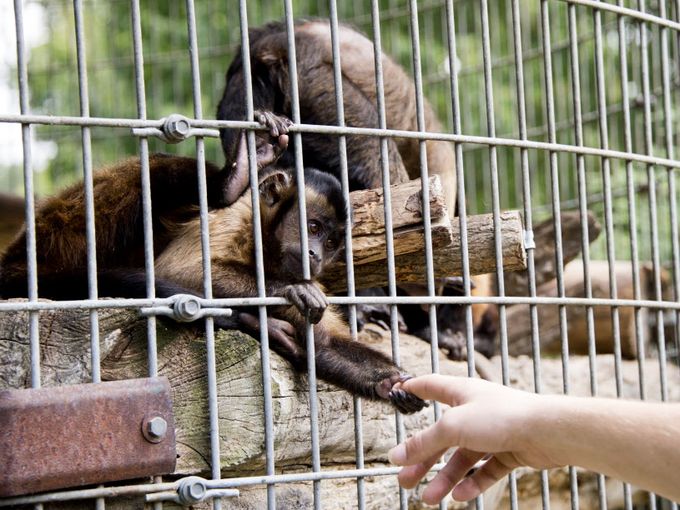How To Stop Exotic Animal Abuse At Roadside Zoos
Roadside zoos and public menageries can be establish all across the U.S. These facilities are oft advertised as "fun" or "heady" pit stops along the highway that offer a "one-of-a-kind" hazard to collaborate with wild, exotic animals.
Although nigh are not licensed or accredited by the Association of Zoos and Aquariums (AZA), these spectacles display animals such as primates, bears and large cats for paying customers. Existing outside of the standards (albeit, defective standards) of the AZA, roadside zoos and menageries are hotbeds for animal cruelty and abuse.
The U.S. Section of Agriculture (USDA) does have regulations that are meant foreclose abuse and enforce the standards of care for exotic animals at roadside zoos. Unfortunately, state laws regarding the buying of wildlife vary and laws in the southward are peculiarly lax. In places where people can purchase exotic animals, they only need to undergo a uncomplicated awarding process through the USDA to exhibit their animals to the public. In that location is no requirement for exotic brute owners to take knowledge of proper care or needs for their animals; well-nigh are entirely unqualified and unprepared to provide animals with fifty-fifty basic dietary needs.
Roadside zoos and menageries ofttimes allow the public to interact with the animals – a ploy that makes these facilities seem "more than fun" than your typical zoo. Photos with panthera leo and tiger cubs are a common offering. These cubs are bred at the facilities; when they go too old to be "cute" and assisting, they can be bought and sold through the extremely lucrative wildlife merchandise.
Sadly, many cases of abuse at roadside zoos go undocumented until brute welfare groups provide proof from their ain secret investigations. The USDA volition perform routine checks, but they rarely have the funds or staff to effectively check or enforce rules.
While these places can seem like fun, they are anything just for the animals. As Green Monsters, it is up to us to put an finish to this cruelty. The best way to close these businesses downwardly is to cut their funding. If people stop paying to encounter these animals or have photos with them, the cruelty can stop.
With this in heed, here are five of the worst roadside attractions in the U.S. you should avoid at all costs.
1. Tiger Truck End
 Free Tony the Tiger/Facebook
Free Tony the Tiger/Facebook
Perhaps one of the most well-known instances of an animate being being held at a pit end is Tony, the truck cease tiger, who has been living at a gas station in Louisiana for the past 12 years. Michael Sandlin, the owner of Tiger Truck Stop, has long battled animal rights groups in court over Tony'south fate. In 2003, three of Sandlin'south tigers were removed from his intendance due to a number of violations. Still, Tony remained at the truck stop.
Sandlin challenged a 2006 statewide ban on the private buying of exotic cats in 2009. And in 2014, he conspired with a Louisiana lawmaker and produced an exemption to the 2006 ban (Senate Bill 250), one that frees Sandlin from the ban and allows him to keep Tony in captivity.
Sandlin'due south website, SaveTony, pleas for his followers to assist save Tony from the activists trying to take his tiger away from his habitation and for individual citizens to stand up for their rights to own exotic animals.
Luckily, in that location are many people who see correct through this shameless ploy and oppose Tony's captivity. The Fauna Legal Defense Fund continues to campaign for Tony's freedom, click here to learn more nigh their work.
2. Three Bears General Store
 PETA
PETA
In December of 2014, with the help of The Simpsons co-creator Sam Simon, two Himalayan black bears were removed from their physical dwelling at the 3 Bears General Store in Tennessee, and sent to live out the remainder of their lives in a natural habitat at The Wild Animal Sanctuary.
Five other bears, sadly, yet remain.
Three Bears General Store has received a number of USDA violations. Near notably, in 2010, for the "failure to allow the bears to enter their shelters during the solar day in order to escape from public viewing or extreme weather." 3 Bears was too cited for not supplying the bears with an appropriate diet. The animals were beingness fed an array of Milk-bones, apples, melons and grapes.
3. Natural Bridge Zoo
 HSUS
HSUS
After a six-month undercover investigation past the Humane Society of the U.s.a. (HSUS) and a number of complaints, the Virginia chaser general'south office is reviewing numerous accounts of corruption, fail and death at the Natural Bridge Zoo; including the use of bull hooks on the zoo'southward solitary elephant Asha who has been without a companion for 10 years.
HSUS investigators besides documented a primate who was killed with rat poison; tiger cubs ripped from their mothers and canteen fed by zoo patrons; the death of malnourished giraffe who had been bred too many times and many other horrors.
The pitiful and agonizing allegations fabricated against the Natural Bridge Zoo call into question the quality of intendance they're providing for their animals. Some have come to defend the zoo, while the owner of the zoo calls the unabridged situation a "witch hunt" brought on by animals rights groups in an endeavor to heave donations, but nosotros remember the video speaks for itself. (Warning, it'due south graphic.)
4. Wild animals In Need
 Wildlife in Need, Indeed?/Facebook
Wildlife in Need, Indeed?/Facebook
Owner of Wild fauna In Need, Tim Stark, is a cocky appointed adept in the field of big cats and other wild animals. Stark's operation has been open in Indiana since 1999 and has faced controversy over the years. In fact, Stark has been cited by the USDA for at least 22 violations in the by several years, including a number of violations pertaining to Stark's "Tiger Baby Playtime" in which he charges the public, on average $20-$25, to interact with the animals and take pictures with them.
In 2007, Stark struck a plea deal later being charged with selling and transporting an endangered ocelot to a buyer in Texas. About recently, volunteers have come forrard with graphic accounts of exactly how Stark runs his performance.
He's defendant of hiring volunteers with little to no experience working with wildlife, and disregarding the advice of his veterinary. In the aforementioned account, Stark came under fire for bringing a 250-pound tiger directly in front end of the public during a standard show with no barrier to split up them. During one bear witness, the tiger became ambitious, an incident that Stark "played off" to keep the audience calm.
5. Tuttle's Tiger Safari

An undercover investigation by HSUS of the tiger safari in Oklahoma is an example of the kind of abuse and trauma young cubs go through in order to plough a profit for roadside zoos. Owner Bill Meadows refutes the allegations, but the video which graphically shows Meadow'south apprehension of his upcoming USDA visit and the exploitation and abuse of his cubs, including i in detail, Maximus, being dragged and slapped past employees, speaks volumes about his credibility and compassion.
According to the HSUS, Bill Meadows has received ii official warnings since 2012 and over fourteen pages of violations during the almost recent inspection.
Is There Hope?
Although the outlook for many of these animals seems dismal, there is yet hope. Ricky the acquit was recently relocated to the Wild Animal Sanctuary after living at an ice cream parlor in Pennsylvania for more 16 years. A niggling over two years ago, Ben the bear was released to PAWS Ark Sanctuary in California after living at Jambbas Ranch in Due north Carolina for half dozen years.
Conservation does not entail simply breeding and housing these exotic animals so that spectators may gawk at and pose with for a price. This kind of "instruction" does nothing more than then perpetuate the growing epidemic and notion that wild animalsmake good pets.
It's essential that we, every bit Light-green Monsters, proceed to educate and pass this information along to our friends and loved ones, peculiarly young children, about the importance of conserving these magnificent animals. The more people know nigh these roadside zoos, the less probable they'll be to visit one.
If you always doubtable a case of animate being corruption or neglect, be sure to report it.
Lead image source: Michelangelo-36/Wikipedia
Source: https://www.onegreenplanet.org/animalsandnature/horrific-roadside-zoos-and-exotic-animal-menageries-in-the-u-s/
Posted by: allenmignobt.blogspot.com



0 Response to "How To Stop Exotic Animal Abuse At Roadside Zoos"
Post a Comment